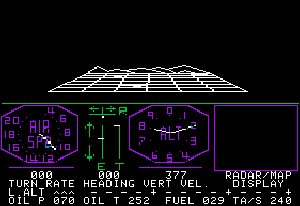FS1 Flight Simulator
| FS1 Flight Simulator | |
|---|---|
 TRS-80 cover art | |
| Developer(s) | Sublogic |
| Publisher(s) | Sublogic |
| Designer(s) | Bruce Artwick Stu Moment |
| Programmer(s) | Bruce Artwick |
| Platform(s) | Apple II, TRS-80 |
| Release | Apple II TRS-80 1980 |
| Genre(s) | Amateur flight simulator |
| Mode(s) | Single-player |
FS1 Flight Simulator is a 1979 video game published by Sublogic for the Apple II. A TRS-80 version followed in 1980. FS1 is the first in a line of simulations from Sublogic which, beginning in 1982, were also sold by Microsoft as Microsoft Flight Simulator.
Sublogic later released updated versions for both the Apple II and TRS-80 on 5 1⁄4 inch diskettes. The updates include enhanced terrain, help menus, and a bomb sight.
Gameplay[edit]

FS1 Flight Simulator is a flight simulator in which the player pilots a somewhat modernized Sopwith Camel.[2]
Development[edit]
Computer-graphics specialist Bruce Artwick and pilot and marketing student Stu Moment were roommates at the University of Illinois. Released for the Apple II computer as A2-FS1 Flight Simulator with British Ace - 3D Aerial Battle,[3] it was their first product after forming Sublogic,[4] has black and white wireframe graphics, with very limited scenery consisting of 36 tiles (in a 6 by 6 pattern, which roughly equals a few hundred square kilometers), and provides a very basic simulation of one aircraft.
Sublogic advertised that the $25 FS1 "is a visual flight simulator that gives you realistically stable aircraft control", with a graphics engine "capable of drawing 150 lines per second".[5]
Ports[edit]
The simulator was later ported to the TRS-80 Model I under the name T80-FS1,[6] which has only rudimentary graphics capability. Because of the TRS-80's limited memory and display, the instrument panel was dropped and the resolution of the cockpit window display reduced.
Reception[edit]
J. Mishcon reviewed FS1 Flight Simulator in The Space Gamer No. 31. Mishcon commented that "all things considered, this is single most impressive computer game I have seen. It creates a whole new standard. I most strongly urge you to buy it and see for yourself".[2]
Bob Proctor reviewed the game for Computer Gaming World, and said that "although there are other flight simulators, the Sublogic program remains unique for the built-in dogfight game. While raving about the simulation, reviewers have called the game 'difficult', 'challenging', and 'next to impossible'".[7]
Flight Simulator sold 30,000 copies by June 1982, tied for third on Computer Gaming World's list of top sellers.[1]
Reviews[edit]
References[edit]
- ^ a b "Inside the Industry" (PDF). Computer Gaming World. September–October 1982. p. 2. Retrieved 2016-03-28.
- ^ a b Mishcon, J. (September 1980). "Capsule Reviews". The Space Gamer (31). Steve Jackson Games: 28.
- ^ "sublogic_a2fs1_manual" (PDF). fs1.applearchives.com. Retrieved 2023-12-01.
- ^ Hockman, Daniel (April 1987). "Bruce Artwick's Flight Simulator / You've Come A Long Way, Baby! / The History of an Epic Program". Computer Gaming World. No. 36. pp. 32–34. Retrieved 23 April 2016.
- ^ "New for the Apple II & TRS-80... the subLOGIC FS1 Flight Simulator!". BYTE (advertisement). January 1980. p. 94.
- ^ "Flight Simulator". mobygames. Retrieved 2023-12-01.
- ^ Proctor, Bob (March–April 1982). "You Too Can Be an Ace!". Computer Gaming World. Vol. 1, no. 3. pp. 32–33.
- ^ "SoftSide Magazine Issue 28 (Convoy)". January 1981.
- ^ "80 Microcomputing Magazine August 1981". August 1981.
- ^ https://strategyandtacticspress.com/library-files/Moves%20Issue56.pdf
